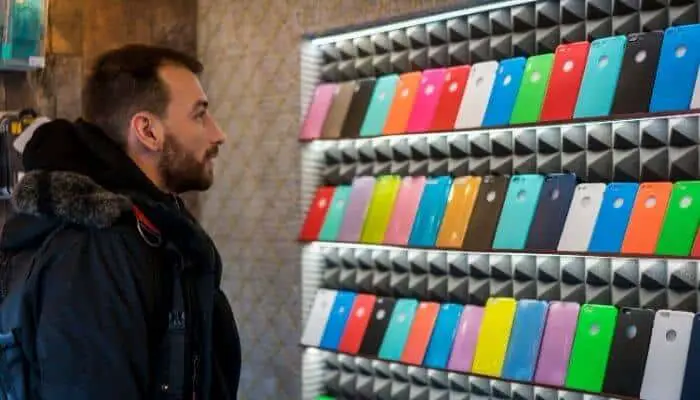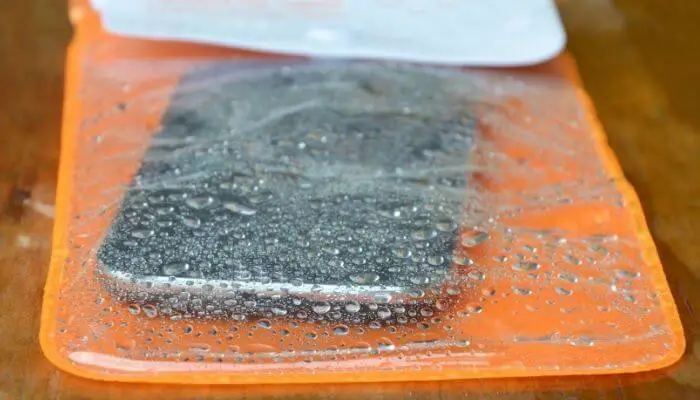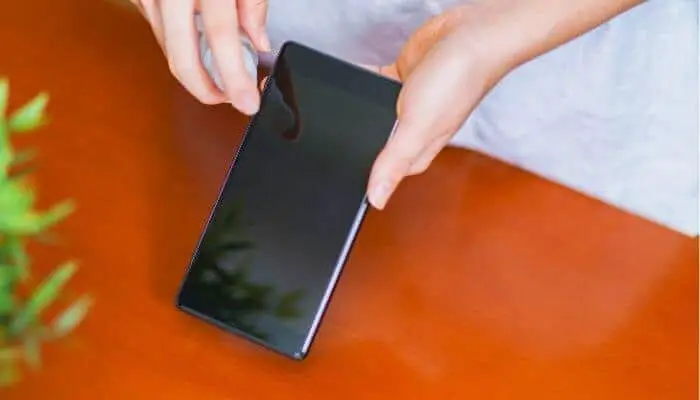While some phones are water-resistant very few are fully waterproof.
Knowing how to properly waterproof your phone can save you a lot of trouble.

3 of the best ways to waterproof your phone are:
- Use a waterproof case
- Use a dry bag
- Apply a layer of nano-coating
How to Waterproof Your Phone
Back in the day, the slightest moisture could damage your phone forever.
However, phones have improved, and many newer models are water-resistant. Some of them can even handle being submerged for a few minutes.
However, it’s never recommended to get into the pool or sea with your phone, even if it’s rated as water-resistant.
This is why you need to make a few adjustments to make sure that your phone is waterproof.
1. Get a Waterproof Phone Case
A waterproof phone case protects your device from moisture as well as shocks.
If you’re into outdoor adventures or like to go hiking, river trekking, or mountain climbing, this case will be an excellent investment because it protects your phone.
Phone cases can be soft or hard, depending on your preferences.
A soft phone case provides proper insulation and is usually made of a durable material like silicone.

It doesn’t add weight to the phone, and it feels better in your hands. Moreover, you’ll be able to access all the buttons quickly, even if your hands are wet.
In most cases, the case also comes with a built-in skin protector to protect the screen from scratches.
You should invest in a soft cover if you’re looking for adequate waterproof protection.
Whether you’re fishing, boating, or using your phone for everyday use, this will be the right choice for you.
A hard phone case such as an Otterbox provides more resistance to impact and allows you to access buttons easily.
This is the best choice for a hardcore outdoor enthusiast because it’s shockproof and increases the durability of your phone, in addition to providing water resistance.
A hard cover is more resistant to shock. You can use it while camping, mountain climbing, or even if you’re spending time outside where your phone can be subject to hail and snow.
When comparing these two types, a hard phone case is more water-resistant. However, it feels bulky, and the sound can be a little muffled.
Phone covers are not designed to last forever. Exposure to the sun and salt water will affect the durability and waterproof features of the cover.
If the case features a built-in screen protector, you need to remove it before installing your case. Two cases on top of each other will create a weak seal that actually damages your phone.
You also need to make sure that you’re applying the seal correctly. Without adequate application, the seal will be useless because it might let the water in.
Best Used For:
- Soft covers are suitable for boating or fishing.
- Hard covers are suitable for mountain climbing, river trekking, or camping.
If you don’t have access to a waterproof phone case there are numerous ways you can still waterproof your phone without a case.
2. Use a Waterproof Dry Bag
A waterproof dry bag is an affordable and practical option that protects your phone from the water.
It also protects the mic and screen from dirt when you’re away from home. It prevents the sand from affecting the mic or speaker when you’re spending time at the beach.
A dry bag comes with a lanyard that you can tie around your hands or neck when you’re engaging in other activities.
This way, you’ll have continuous access to your phone while making sure that it’s waterproof and adequately protected.
The quality of a lanyard is crucial because if it breaks, your phone will be lost forever, especially if you’re diving.

However, a phone dry bag doesn’t provide adequate impact protection. Moreover, it might affect the use of the camera underwater.
A dry bag will be perfect if you’re fishing or hiking because it doesn’t limit the motion of your hands.
It’s always recommended to inspect the dry bag before heading on an outdoor adventure. Inspect the seams and make sure that the bag will keep the water away from your device.
Although a dry bag is a bit roomy, you shouldn’t add other items to it. Keys, credit cards, and other smaller items shouldn’t be kept inside the dry bag with your phone.
You need to make sure there’s no air inside the pouch before sealing it, as this can cause excess condensation to build up.
Release as much air as possible before sealing the dry bag and wait until it’s the same temperature as the outside environment before removing it.
Best Used For:
- A dry bag allows you to move your hand while you’re fishing or hiking.
- It’s suitable for swimming and diving.
3. Use a Nano Coating
Nano-coating is a new technology that improves the waterproof and scratch-resistant features of your phone.
A professional applies the coating using a special machine to enhance the phone’s durability and make it more resistant to the elements.
Although you can apply the nano-coating by yourself, it’s recommended to hire a professional to do this job.
He or she places the phone in a vacuum chamber of a special machine, and the coating is applied in vapor form.

A waterproof film forms around the phone, protecting it from every angle, so you won’t worry about missing any spot.
This technology is more expensive than the other options, but it’s also more efficient. The coat applied allows the water droplets to slide off the surface of your phone, even if it’s not designed to be water-resistant.
It doesn’t affect the visibility of the screen and makes it also resistant to bacteria.
One of the advantages of this technique is that it doesn’t add any weight to your phone. It doesn’t affect the sensitivity of the screen, camera, or the functionality of the buttons.
In some cases, it might affect the brightness of the screen, but this is a minor disadvantage that users usually ignore.
However, this technique doesn’t protect your phone in case it’s submerged underwater. It’s more suitable for everyday water damage, accidental spills, and light rain showers.
Nano-coating applications wear out with time. You need to reapply a new coating every one or two years to make sure that your phone is adequately protected.
This method works best for fishing, boating, hiking, and other outdoor activities where your phone isn’t supposed to be submerged in water.
Best Used For
- It’s best used for fishing, boating, and other outdoor activities.
Wrap Up
Although some phones are water-resistant to a degree, there are several methods that can help increase the waterproof qualities of your device.
A cover will help keep the water away. There are soft and hard covers that you can buy, based on the nature of your activities.
A dry bag is designed to protect your phone in case of submersion, but you need to make sure that the bag is perfectly sealed.
If you’re looking for a method to protect your phone from everyday water spills, a nano-coating will be the right one for you.
You need to reapply the coating every year to guarantee that your phone is protected.

